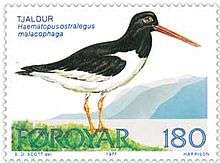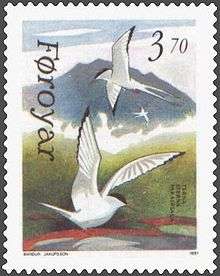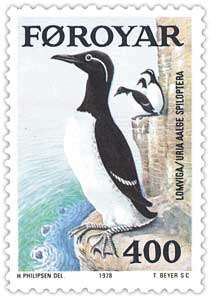List of birds of the Faroe Islands
In the Faroe Islands there are currently about 110 different species of birds although, including vagrants. During the last 150 years, over 260 species have been recorded. There are about 40 common breeding birds, including the seabirds fulmar (600,000 pairs), puffin (550,000 pairs), storm petrel (250,000 pairs), black-legged kittiwake (230,000 pairs), guillemot (175,000 pairs), Manx shearwater (25,000 pairs).


Symbolically, the most important of the birds of the Faroe Islands is the Eurasian oystercatcher (Haematopus ostralegus). Their annual arrival on about 12 March is celebrated by the Faroe Islanders as the start of spring. For this reason, the tjaldur (pronounced [ˈtʃaldʊɹ]), is recognised as the national bird of the Faroes. However, in numbers, the avifauna is dominated by an estimated two million pairs of breeding seabirds of several species. There are also some resident landbirds and many regular visitors, both passage migrants and breeders, as well as several species recorded occasionally as vagrants, mainly from Europe. The Faroese postal system, the Postverk Føroya, prints stamps portraying Faroe birds. See external links.
History
In the 19th century, the islands were occasionally visited by black-browed albatross; one bird regularly summering with gannets for 34 years before it was shot for the Natural History Museum in Copenhagen. The great auk also visited the Faroes and may have bred there, but became extinct throughout its range in the North Atlantic in the early 19th century due to human predation. The pied raven, a colour morph of the common raven, also occurred but disappeared by the middle of the 20th century.
Historically, harvesting seabirds for food was an important source of nutrition for the islanders. A reduced and strictly regulated harvest, mainly of fulmars and puffins, continues. In general, the seabirds and their nesting areas are now strongly protected.
List of birds
The most common birds are listed with their Faroese names too.
Anatidae
- Canada goose - introduced
- Brent goose (helsigás) - visitor
- Greylag goose (grágás) - breeding
- Greater white-fronted goose (korngás) - visitor
- Pink-footed goose (íslandsgás) - visitor
- Barnacle goose (øshvít gás) - breeding
- Snow goose - visitor
- Mute swan (knubbsvanur) - introduced
- Whooper swan (svanur, okn) - visitor
- Common shelduck - vagrant
- Mallard (villdunna) - breeding
- Blue-winged teal - vagrant
- Green-winged teal (krikkont) - breeding
- Gadwall - vagrant
- Eurasian wigeon (ennigul ont) - breeding
- American wigeon - visitor
- Northern pintail (stikkont) - breeding
- Garganey - vagrant
- Northern shoveler - vagrant
- Common pochard - vagrant
- Tufted duck (trøllont) - breeding
- Ring-necked duck - vagrant
- Greater scaup - visitor
- Common eider (æða) – breeding
- King eider (æðukongur) - vagrant
- Steller's eider - vagrant
- Common scoter (kolont) – vagrant
- Velvet scoter - vagrant
- Surf scoter - vagrant
- Long-tailed duck (ógvella) - visitor
- Common goldeneye (súgont) - visitor
- Barrow's goldeneye (íslendsk súgont) - vagrant
- Red-breasted merganser (toppont) – breeding
- Common merganser (tannont) – vagrant
Phasianidae
- Common quail (vaktil) – former breeding visitor
- Black grouse - breeding
- Rock ptarmigan – introduced
- Willow ptarmigan - introduced
Gaviidae
- Red-throated diver (lómur) – breeding
- Black-throated diver (øssvartur lómur) – vagrant
- Great northern diver (havgás) – visitor
- White-billed diver (nevgulur lómur) - visitor
Podicipedidae
- Little grebe (smágjør) – vagrant
- Slavonian grebe (gjør) – breeding
- Red-necked grebe – vagrant
Diomedeidae
- Black-browed albatross (súlukongur) - vagrant
Procellariidae
- Northern fulmar (havhestur) - breeding with 600,000 pairs and a certain population stays all year long
- Manx shearwater (skrápur) – breeding with 25,000 pairs
- Great shearwater – visitor
- Mediterranean shearwater - vagrant
Hydrobatidae

- European storm petrel (drunnhvíti) - breeding with 250,000 pairs, most of them to be observed from August to November
- Leach's storm petrel (sýldur drunnhvíti, havtyrðil) – breeding with 10,000 pairs
Sulidae

- Northern gannet (súla) - breeding only in Mykines with 2,000 pairs.
Phalacrocoracidae
- Great cormorant (hiplingur) - breeding
- European shag (skarvur) – breeding
Ardeidae
- Great bittern - vagrant
- American bittern - vagrant
- Little bittern - vagrant
- Black-crowned night heron - vagrant
- Grey heron (hegri) - visitor
- Purple heron – vagrant
Threskiornithidae
- Common spoonbill - vagrant
- Glossy ibis – vagrant
Pandionidae
- Osprey (fiskiørn) – vagrant
Accipitridae
- European honey buzzard – vagrant
- White-tailed sea eagle – vagrant
- Eurasian sparrowhawk - vagrant
- Rough-legged buzzard - vagrant
- Hen harrier - vagrant
- Western marsh harrier – vagrant
- Black kite - vagrant
Falconidae

- Gyrfalcon – visitor
- Peregrine falcon - vagrant
- Merlin (smyril) - breeding
- Common kestrel – visitor
Rallidae
- Water rail (jarðakona) - visitor
- Baillon's crake – vagrant
- Spotted crake – vagrant
- Corncrake (akurskrift) – vagrant
- Common moorhen - visitor
- Eurasian coot – visitor
Gruidae
- Common crane – vagrant
Haematopodidae
- Eurasian oystercatcher (tjaldur) - breeding
Recurvirostridae
- Pied avocet - vagrant
Charadriidae
- Ringed plover (svarthálsa) – visitor
- Killdeer - vagrant
- Eurasian dotterel - vagrant
- Eurasian golden plover (lógv) - breeding
- Grey plover – vagrant
- Northern lapwing (vípa) - breeding
Scolopacidae


- Eurasian woodcock - visitor
- Common snipe (mýrisnípa) (sub-species Faroese snipe) – breeding
- Jack snipe - visitor
- Ruddy turnstone - visitor
- Little stint - vagrant
- Purple sandpiper (sjógrælingur) - breeding
- Dunlin (fjallmurra) - breeding
- Red knot - visitor
- Sanderling - visitor
- Ruff - visitor
- Common sandpiper - vagrant
- Wood sandpiper - vagrant
- Common redshank (stelkur) - breeding
- Common greenshank - vagrant
- Black-tailed godwit (reyðspógvi) - breeding
- Bar-tailed godwit - visitor
- Eurasian curlew - visitor
- Whimbrel (spógvi) – breeding
- Grey phalarope - visitor
- Red-necked phalarope (hálsareyði) – breeding
Stercorariidae
- Great skua (skúgvur) - breeding with 450 pairs
- Arctic skua (kjógvi) - breeding with 900 pairs
- Pomarine skua (jói) – visitor
- Long-tailed skua (snældukjógvi) - visitor
Laridae

- Little gull - vagrant
- Black-headed gull (fransaterna) - breeding with 250 pairs
- Lesser black-backed gull (likka) - breeding
- Herring gull (fiskimási) - breeding with 1,500 pairs
- Iceland gull (lítil valmási) – visitor
- Glaucous gull (valmási) – visitor
- Great black-backed gull (svartbakur) - breeding with 1,200 pairs
- Common gull (skatumási, skata, gneggjus) - breeding with 1,000 pairs
- Sabine's gull - vagrant
- Black-legged kittiwake (rita) - breeding with 230,000 pairs
- Ross's gull - vagrant
- Ivory gull – visitor
- Black tern - vagrant
- White-winged black tern - vagrant
- Caspian tern - vagrant
- Arctic tern (terna) - breeding with 2,000 pairs
- Little tern - vagrant
Alcidae

- Little auk (fulkubbi) - visitor
- Razorbill (álka) - breeding with 4,500 pairs
- Great auk (gorfuglur) - extinct
- Common guillemot (lomvigi/a) - breeding with 175,000 pairs
- Brunnich's guillemot (íslandslomvigi/a) - visitor
- Black guillemot (teisti) - breeding with 3,500 pairs
- Atlantic puffin (lundi) – breeding with 350,000 pairs
Pteroclidae
- Pallas's sandgrouse – vagrant
Columbidae
- Rock dove (bládúgva) – breeding
- Wood pigeon - visitor
- Turtle dove – visitor
Cuculidae
- Common cuckoo – vagrant
Strigidae
- Snowy owl – visitor
- Long-eared owl – vagrant
- Short-eared owl – visitor
- Eurasian scops owl – vagrant
Caprimulgidae
- Common nighthawk – vagrant
- European nightjar – vagrant
Apodidae
- Common swift – breeding
Coraciidae
- European roller – vagrant
Picidae
- Wryneck – visitor
- Great spotted woodpecker – visitor
Hirundinidae
- Common house martin (lonsvala) - breeding
- Sand martin - vagrant
- Barn swallow (svala) – breeding
Motacillidae
- White wagtail (erla kongsdóttir) - breeding
- Blue-headed wagtail - visitor
- Yellow wagtail - vagrant
- Grey wagtail - vagrant
- Rock pipit (grátitlingur) – breeding
- Meadow pipit (titlingur) – breeding
Bombycillidae
- Waxwing – visitor
Cinclidae
- White-throated dipper - vagrant
Troglodytidae
- Eurasian wren (músabróðir) – breeding
Prunellidae
- Dunnock – vagrant
Turdidae
- Dusky thrush – vagrant
- Blackbird (kvørkveggja) - breeding
- Song thrush - visitor
- Redwing (oðinshani) - breeding
- Fieldfare - visitor
- Ring ouzel – vagrant
- Scaly thrush – vagrant
Corvidae
.jpg)
- Jackdaw – visitor
- Rook - visitor
- Hooded crow (kráka) – breeding
- Common raven (ravnur) - breeding (see also: Pied raven)
Acrocephalidae
- Sedge warbler – vagrant
- Eurasian reed warbler – vagrant
- Great reed warbler – vagrant
Phylloscopidae
- Common chiffchaff – visitor
- Wood warbler – vagrant
- Arctic warbler – vagrant
- Yellow-browed warbler – vagrant
Sylviidae
- Barred warbler – visitor
- Garden warbler (garðljómari) – visitor
- Eurasian blackcap – visitor
- Common whitethroat – visitor
- Lesser whitethroat (notuljómari) – visitor
Regulidae
- Goldcrest – visitor
- Common firecrest – vagrant
Muscicapidae
- Whinchat – vagrant
- European stonechat – vagrant
- Northern wheatear (steinstólpa) - breeding
- Black redstart – vagrant
- Common redstart – visitor
- European robin – visitor
- Red-spotted bluethroat – vagrant
- Pied flycatcher - visitor
- Red-breasted flycatcher – vagrant
- Spotted flycatcher – vagrant
- Brown flycatcher – vagrant
Laniidae
- Red-backed shrike - vagrant
- Great grey shrike – vagrant
Emberizidae
- Corn bunting – vagrant
- Yellowhammer – visitor
- Red-headed bunting – vagrant
- Ortolan – vagrant
- Reed bunting – vagrant
Calcariidae
- Lapland bunting – vagrant
- Snow bunting (snjófulgur) – visitor
Fringillidae
.jpg)
- Common chaffinch - visitor
- Brambling (fjallafinka) - visitor
- Hawfinch – vagrant
- Greenfinch - visitor
- Siskin – vagrant
- Linnet – vagrant
- Twite (íriskur) – vagrant
- Common redpoll - visitor
- Common crossbill - visitor
- Two-barred crossbill – vagrant
- Common rosefinch – vagrant
- Eurasian bullfinch – vagrant
Passeridae
- House sparrow (gráspurvur) – breeding
- Tree sparrow (gerðisspurvur) – breeding
Sturnidae
- Common starling (stari) – breeding, endemic subspecies
- Rosy starling - vagrant
Oriolidae
- Golden oriole - vagrant
Places
Excellent places for watching seabirds (guillemots, kittiwakes and puffins are common everywhere) including:
- Svínoy with many great skuas
- The Vestmanna cliffs with a boat tour
- Mykines has the only Faroese population of gannets
- Nólsoy has the largest colony of storm petrels in the world
- Skúvoy with the largest Faroese colony of guillemots and lots of great skuas, which gave the island its name
- Suðuroy has at the west coast the best accessible bird cliffs from the land side
See also
References
- Williamson, Kenneth. (1970). The Atlantic Islands. Collins: London. (2nd edition). ISBN 0-7100-6911-1
External links
| Wikimedia Commons has media related to Birds on Faroese stamps. |
- About the stamps and the birds
- PDF download of Faroese birds (652.31 KB, 4 pages)
- Faroenature.net - Bird Names (Latin, Faroese, English, Danish, German, Norwegian, Swedish)